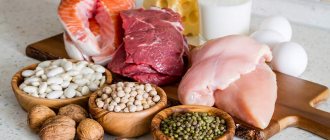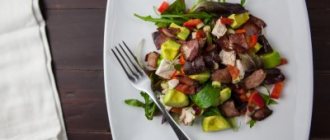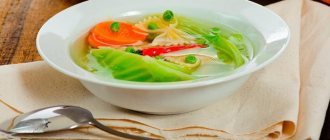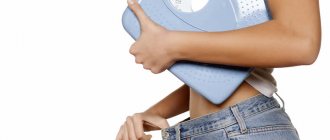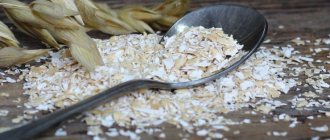Proper nutrition in old age
What happens to the body in old age, the nutrition “pyramid” or what foods an elderly person should eat, what diet is optimal - we tell you in this article.
This appeal is not just to older people, but to their children in the first place. It is very important to understand the processes that occur in the human body. When a person crosses the threshold of 60-65 years, certain changes begin. They are not only external, but also internal. The metabolic process slows down, it takes more time to digest food, physical activity decreases, and the amount of energy that a person ate before is no longer needed. At this age people are often left alone. Children live separately, there is no longer the need to cook a lot, cook deliciously, decorate something in order to please your son or grandson. For yourself, soup, a sandwich and a cup of tea are enough.
Going through a checkup means getting ahead of the onset of health problems.”
More details
This is exactly what gradually leads to energy deficiency, which occurs in old age. There is such a wonderful expression: we are what we eat. It has long been known that by changing a certain eating style, you can change the processes that occur inside the body. There is a fairly important area - nutrition in old age, or gerodietics, as it is called. This is the direction of medicine that allows you to slow down the rate of aging or prevent pathological aging processes.
For older people, the traditional food pyramid, which is used by most nutritionists around the world, has been slightly modified. The main idea that is included in this nutrition pyramid for an elderly person: this is, firstly, that the energy balance is somewhat reduced, an elderly person needs about 1200–1600 kcal per day, and at the base of this nutrition pyramid there is another layer which is called water, or liquid.
According to all recommendations, an elderly person should drink at least 8 glasses of water per day. Like any flower, our body also requires watering, and if we constantly do not consume liquid or do not consume enough of it, then our roses will wither, our cells will shrink a little, the transport of substances will be disrupted, and the metabolism will also change not for the better.
Carbohydrates are the main component of energy metabolism. It is very important to eat anywhere from 6 to 11 servings. What it is? This is, for example, 3 slices of bread, 2 potatoes, a bowl of porridge, half a glass of pasta. A regular diet that anyone can easily afford during the day.
Next, which is very important, are proteins. In old age, you need to eat enough protein, because it is a transporter of medicines - these little trains that carry medicines. If there is not enough protein, then drugs do not travel through the body as efficiently and, accordingly, there is no such effect from treatment. You need to eat about 120-150 grams of protein - this is fish, poultry, beef, and about 2-3 servings of dairy products - this is a glass of milk or kefir, about 6 tablespoons of cottage cheese or cheese. This will be enough to maintain your protein metabolism at a normal level.
In old age, and not only in old age, fats occupy the very top of the nutrition pyramid, and an elderly person does not need them in large quantities. We have already talked about atherosclerosis, about the risks that exist, so it is very important that an elderly person who still consumes fats changes his view of vegetable fats. For example, it is better to make a salad not with mayonnaise or full-fat sour cream, but with olive or sunflower oil. Because fats in large quantities are not needed in old age. Moreover, if the food is fatty, it often leads to the development of a disease such as atherosclerosis.
Minerals and vitamins are very important, everything that supports metabolism. Therefore, you definitely need to eat vegetables and fruits (at least 2-3 servings). This is, for example, one banana, one apple during the day, one carrot, one tomato, one cucumber. It is quite affordable, anyone can afford it.
If a person takes any supplements, vitamins (because vitamin D is needed, vitamin B12 is necessary in old age), then one should definitely consult with a doctor about the choice of these food supplements, multivitamins and those containing minerals. It is important to understand the composition of these supplements, and it is important not to overdose.
It is difficult to answer unequivocally the question of what diet is optimal for an elderly person, because it all depends on the diseases that he may have. Optimally, this is still a Mediterranean diet: a large amount of vegetables, salads, cucumbers, tomatoes. All those carbohydrates and minerals are contained there, as well as a fairly large amount of fish or poultry, meat, salads, usually seasoned with vegetable oil. A small, modest glass of wine is also usually included in the Mediterranean diet. This is not to say that alcohol is contraindicated in old age. As at any other age, you can use it, it’s a matter of quantity. An elderly person can easily afford one glass of red wine with dinner.
What else is important in catering? Surprisingly, physical activity is very important, because with age the processes slow down somewhat, and in the absence of physical activity they slow down even more. What is good for old age? In principle, any type of physical activity that is available for health reasons and strength. These include walking, swimming, water aerobics, Nordic walking, dancing, tennis, whatever pleases you. It could even be just working in the garden, or walking, for example, in the country. All this contributes to the fact that digestion is most active.
In old age, you should try not to eat large amounts of food at once. It is better to eat little by little, but at least 5-6 times. The optimal meal for an elderly person is 5 times a day. The very process of cooking in old age often becomes a problem if a person has Alzheimer's disease, for example, or some manifestations of senile dementia. If you have arthritis, there is osteoporosis, when it is simply physically impossible to cut, grate and cook something for yourself. But even active older people do not always prepare their own food correctly, and are often content with some kind of semi-finished products. Of course, depression, the condition of the oral cavity, poorly restored teeth - all this affects the processes of food digestion.
We want to appeal to those people who are now 30–40 years old and who have elderly relatives. Please pay attention to how they eat, it is really very important. This allows you to prevent a large number of diseases. Try to provide them with the right foods, at least for a week. On the weekend, go to the store, buy and put food in the refrigerator for them, from which they can cook for themselves. Please control their appetite. If you notice that your appetite is decreasing, pay attention to this and consult a doctor, because this may be the cause of some kind of disease.
Examination in a hospital with comfort
More details
Try to organize family dinners, get-togethers at least 2 times a month, maybe take the person to a restaurant. The positive emotions that a person experiences while communicating over food are actually very important in order to form the right attitude towards nutrition. If you do not live together, then please call your parents more often, ask how they are doing, what they ate for lunch today. This will be an additional incentive for them to cook something, eat something, because they will definitely need to share this information with you. Believe me, this is very important for them.
Pay attention to how they eat. If they have any metabolic diseases, such as obesity or diabetes, of course, an individual diet is needed. The doctor you contact will definitely do this.
You can make an appointment with a doctor by phone or online.
But, one way or another, at any age, try to eat right so that you live long, actively, so that you have fewer health-related problems. We wish you health and happiness.
Proper nutrition for women after 55 years
To maintain a stable weight, nutritionists recommend switching to proper nutrition. This should become a habit for the rest of your life. Healthy food is a guarantee of a slim figure. In this case, you should follow the recommendations:
- The amount of food consumed should be measured. It is difficult for the body to digest excess food. The recommended serving dose is 250-280 grams;
- The diet should include 5-6 meals. In this case, you should have dinner at least 3 hours before bedtime. Otherwise, the food will not be digested and will turn into fatty deposits, and in the morning the woman will experience heaviness in the stomach and malaise;
- More than half of the foods consumed during the day should be vegetables and fruits. It is advisable to consume them fresh;
- It is recommended to prepare dishes immediately before consumption. Heated food loses nutrients;
- the daily diet should be rich in vitamins and minerals;
- carbohydrates should enter the body in the morning. Porridge is an ideal breakfast option. It will provide energy for the whole day;
- fried, spicy foods should become taboo. It is recommended to boil or steam dishes;
- you should avoid baking and sweets;
- preference should be given to vegetable fats;
- to prepare soup you must use recycled meat broth;
- meat, fish and dairy products should be low-fat. However, milk is prohibited;
- fruits are recommended to be consumed before lunch;
- Once a week you can allow yourself to drink a glass of dry wine.
To increase the effectiveness of a diet, how to lose weight at 55 years old for a woman at home, you need to count your daily calorie intake. In the absence of loads, the indicator should not exceed 1500 kcal. With an active lifestyle, 200 kcal per day is allowed. The drinking regime deserves attention. You can only drink clean, still water.
Nutrition rules for women of any age
At 20, it’s easy to lose weight, at 30 it’s not difficult to stay in shape, at 40 it becomes more difficult to stay slim, and by the age of 50, even the most athletic of us begin to develop a belly. In addition, during menopause, any “extra” snack grows to the waist. That is why each age has its own rules of nutrition and physical activity.
Physical activity in any person decreases with every ten years, metabolic processes also gradually slow down, while the diet of most of us changes little, sometimes quite the opposite: with age we allow ourselves too much, pamper ourselves, sometimes compensating for the lack of sex and love or interesting new events.
Age and excess weight
Currently, there are sad statistics - a number of diseases have become significantly younger. Heart and stomach problems, osteochondrosis accompany the modern young woman. Experts say that the strong “rejuvenation” of diseases is directly related to excess weight. Let's look at the basic rules of nutrition and physical activity for each age in order to remain young and beautiful for a long time.
Ideal parameters
First, let's decide how much you should weigh, taking into account your age and body type.
There are three body types: asthenic, normosthenic, hypersthenic. To determine what type of figure your body is, clasp the thumb and forefinger of your right hand around the wrist of your left, where the bone is. If you succeeded easily, there is still room left - you are an asthenic (thin body type), if you succeeded, but with great difficulty, you are a normosthenic (normal body type), if you couldn’t clasp your wrist, you are a hypersthenic (thick body type ).
| Age | Asthenic | Normosthenik | Hypersthenic |
| 30 years | 50-60 kg | 55-65 kg | 60-70 kg |
| 40 years | 52-62 kg | 57-67 kg | 62-72 kg |
| 50 years | 55-65 kg | 65-75 kg | 70-80 kg |
| 50+ years | 58-68 kg | 68-78 kg | 72-80 kg |
Now, knowing our weight norm, we can move on to information about proper nutrition.
Dietary rules: after 20 years
So, if you are in your early 20s and are thin yourself, this is not a reason to relax, since carcinogenic fats do not look at age. Chips and donuts, pasties and brushwood, salted crackers and nuts are unlikely to add beauty and health to you. Carbonated drinks, especially often consumed instead of water since childhood, can lead to serious liver pathologies, including cirrhosis. Energy cocktails also have a very bad effect on the condition of the stomach and liver. But if your figure is far from perfect, the calorie content of food eaten per day should not exceed 3000 calories. And you need to remove unnecessary fats from your diet - especially a lot of them in sausages, sausages and sausages. Boiled chicken is preferable to dumplings, grilled fish is healthier than fried fish, mayonnaise should be replaced with bio-yogurt. Remember that you need to take care of your appearance from a young age.
Nutrition rules 30+
Vitamins, iron, minerals and antioxidants become essential for a 30-year-old woman. In this case, it is absolutely necessary: two dairy products per day and proteins (proteins) of animal origin with every meal, as they supply building material to the muscles. It is preferable to receive them in small but regular doses, rather than in one “piece” in the evening.
Sample menu for the day
- Breakfast: scrambled eggs (omelet). Such a breakfast will be digested gradually, will force the intestines to work and will reduce the feeling of hunger for a long time.
- Second breakfast: cottage cheese (kefir) or yogurt.
- Lunch: Caesar salad, borscht, grilled fish with vegetables. For lunch, you should not indulge in foods high in carbohydrates: sandwiches, pasta, sweet dishes. And the ideal dessert for office workers and people with minimal physical activity is, of course, fruit.
- Dessert: any fruit (fruit sorbet).
- Dinner: lean meat or poultry with stewed vegetables, vegetable salad. Dinner can be very tasty and healthy, while containing a minimum of calories. Boiled meat or fish (preferably red) will not add extra pounds and will allow the body to receive the nutritional element women need - iron.
- Late dinner: kefir or cottage cheese with fruit.
Water regime: 2 liters of clean water per day.
Daily calorie content: 2300 kcal for inactive people, 2600 kcal for those involved in sports.
Fitness: working out the muscles of the back, abs and buttocks is important not only for the figure, but also for relieving the load on the lower back that occurs at this active age.
Nutrition rules 40+
Psychotherapists consider this age to be a crisis (after all, hormonal levels are changing) and suggest increasing the consumption of foods that can protect against depression. The good mood hormone - serotonin - is found in oatmeal, turkey, chocolate, and fish. Physical health will also benefit you, so don't forget about vegetables. The polyphenols in their composition protect against atherosclerosis, and polystyrenes regulate the production of hormones, compensating for the decrease in ovarian activity.
Starting from the age of 40, the body accumulates fat more easily, because energy needs decrease. Therefore, lean on vegetables and fruits. they will play a role in preventing obesity and will quickly fill you up.
Remember to strengthen your bones to prevent osteoporosis, so eat foods rich in calcium: fish, greens, cheeses, cottage cheese and dairy products.
Sample menu for the day
- Breakfast: oatmeal (you can add nuts) or buckwheat.
- Second breakfast: banana (such breakfasts will benefit the body not only psychologically, but will also help the functioning of the heart and blood vessels).
- Lunch: vegetable soup, chicken or turkey, salad. For lunch, eat foods containing many vitamins and antioxidants: colorful vegetables, fruits, legumes.
- Dessert: fruit.
- Afternoon snack: blueberries, raspberries, cranberries, lingonberries, feijoa fruits. It is believed that the listed berries prevent most serious diseases, including oncology.
- Dinner: fish and vegetables. A fish dish at this age is ideal. There are not many calories, but there are the necessary substances - phosphorus and Omega-3 acids.
Water regime: 2 liters of clean water per day.
Daily calorie content: 2100 kcal for inactive people, 2400 kcal for those involved in sports.
Fitness: There is a risk of gaining extra pounds, it is also important to take care of the spine, so functional training and balance work are excellent.
Nutrition rules 50+
After 50 years, the risk of arthritis and arthrosis increases. Therefore, the ideal solution at this age is vegetables and fruits. Most of them prevent the development of atherosclerosis due to the presence of substances that have a beneficial effect on the metabolism of fats and cholesterol in the body. We also add that plant foods are rich in potassium salts and partly magnesium, which have a beneficial effect on the activity of the cardiovascular system.
Sample menu for the day
- Breakfast: low-fat cottage cheese with herbs. To replenish calcium, include cottage cheese in your diet.
- 2nd breakfast: pears.
- Lunch: vegetable soup, chicken breast, baked vegetables, salad dressed with flaxseed oil.
- Dessert: marmalade, marshmallows, marmalade, marshmallows - low-calorie sweets, you can pamper yourself with them. Avoid flour, milk chocolate, jam - decreased metabolism and increased body weight at this age often lead to the development of type 2 diabetes.
- Afternoon snack: fermented baked milk.
- Dinner: fish balls, stewed potatoes.
- Late dinner: kefir.
Fitness: As you age, in addition to staying active, you need to remember to relieve stress. Stretching will help cope with this task.
For those over 50, sea fish is very useful - it contains iodine, which plays an important role in the prevention and treatment of atherosclerosis. After 50 years, you should limit the amount of extractive substances contained in meat broths, fried meat and fish.
Nutrition rules 55+
After menstruation stops, a woman loses about a kilogram of bone mass every year, so you need to carefully monitor your health! First of all, exclude all carbonated drinks, chips, and coffee-containing drinks, which contribute to the leaching of calcium from the bones. In addition, you should protect yourself from stress and forget about alcohol and cigarettes, because all of this can trigger the development of osteoporosis.
At this age, physical inactivity also manifests itself, so a healthy lifestyle involves not only nutrition, but also necessarily positive emotions, physical activity and physical activity. Don't waste your time sitting at home watching TV. Move, visit, travel! Look for like-minded people if you have any hobby. If it doesn't exist, it's time to start one.

